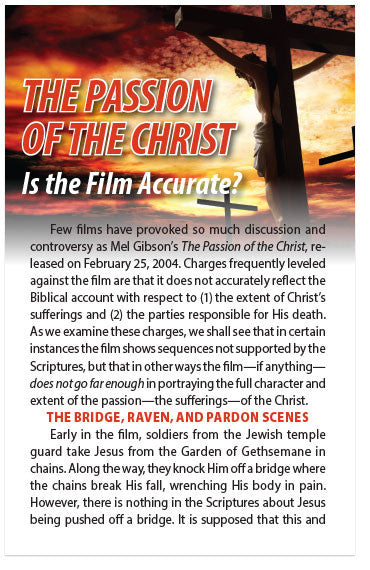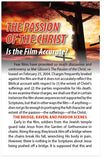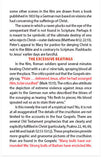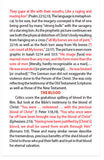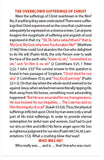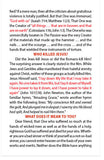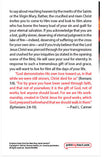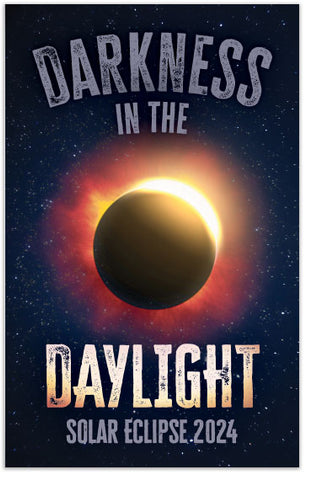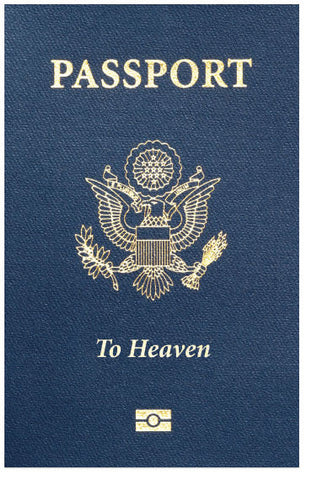The Passion of the Christ: Is the Film Accurate? (NKJV)
Special-Order Folded Tract
 NOTE: This item is custom-printed to order (click for more details).
NOTE: This item is custom-printed to order (click for more details).
This tract is from our print-on-demand library, and is not kept in stock. Select the options below, and we will custom-print a batch just for you. Because this item is custom-printed, you can add your custom imprint to the back page at no extra cost.
- Estimated shipping date: Monday, January 26 (Click for more details)
- SKU:
- Discounts: Discount coupons do not apply to this item
- Format: Folded Tract
- Size: 3.5 inches x 5.5 inches
- Pages: 6
- Imprinting: Available with 4 lines of custom text
- Version: NKJV
- Returns: Because this item is custom-printed to order, it cannot be returned.
Show all item details
The full text of this tract is shown below in the NKJV version. (Do you want to print this tract in a different version than the one listed? Contact us and let us know what you're looking for—we may be able to create the alternate version for you at no charge.)
Few films have provoked so much discussion and controversy as Mel Gibson’s The Passion of the Christ, released on February 25, 2004. Charges frequently leveled against the film are that it does not accurately reflect the Biblical account with respect to (1) the extent of Christ’s sufferings and (2) the parties responsible for His death. As we examine these charges, we shall see that in certain instances the film shows sequences not supported by the Scriptures, but that in other ways the film—if anything—does not go far enough in portraying the full character and extent of the passion—the sufferings—of the Christ.
The Bridge, Raven, and Pardon Scenes
Early in the film, soldiers from the Jewish temple guard take Jesus from the Garden of Gethsemane in chains. Along the way, they knock Him off a bridge where the chains break His fall, wrenching His body in pain. However, there is nothing in the Scriptures about Jesus being pushed off a bridge. It is supposed that this and some other scenes in the film are drawn from a book published in 1833 by a German nun based on visions she had concerning the sufferings of Christ.
The scene in which a raven plucks out the eye of the unrepentant thief is not found in Scripture. Perhaps it is meant to be symbolic of the ultimate destiny of one who rejects Christ—outer darkness (Matthew 8:12; 22:13). Peter’s appeal to Mary for pardon for denying Christ is not in the Bible and is contrary to Scripture. Flashbacks to Jesus’ earlier days are fanciful.
The Excessive Beatings
In the film, Roman soldiers spend several minutes beating Christ with a cat-o’-nine tails, spraying blood all over the place. The critics point out that the Gospels simply say, “Pilate … delivered Jesus, after he had scourged Him, to be crucified” (Mark 15:15). The critics also attribute the depiction of extreme violence against Jesus once again to the German nun who described the blows of the scourging as tearing “His flesh to pieces; His blood spouted out so as to stain their arms.”
Is this merely the rant of a mystical nun? No, it is not at all exaggerated! The details of the crucifixion are not limited to the accounts in the four Gospels. There are several Old Testament prophecies that are clearly and explicitly fulfilled in Christ (particularly, Psalms 22, 40, 69, and 88 and Isaiah 52:13-53:12). These prophecies provide more graphic and gruesome pictures of the crucifixion than are found in the Gospels: “Many bulls have surrounded Me; Strong bulls of Bashan have encircled Me. They gape at Me with their mouths, Like a raging and roaring lion” (Psalm 22:12,13). The language is metaphorical, to be sure, but the imagery conveyed is that of one being gored by many “strong bulls” with the savagery of a starving lion. As the prophetic picture continues we see both the physical distortion of Christ’s body resulting from hanging on a cross (“all My bones are out of joint,” 22:14) as well as the flesh torn away from His bones (“I can count all My bones,” 22:17). The picture is even more graphic in Isaiah 52:14 and 53:5: “His visage [face] was marred more than any man, and His form more than the sons of men [literally, hardly recognizable as a man]…. He was wounded [or pierced through] … He was bruised [or crushed].” The German nun did not exaggerate the violence done to the Person of the Christ. She was only reflecting the testimony of the Old Testament Scriptures as well as those of the New Testament.
The Blood
Critics scorn the gratuitous spilling of blood in the film. But look at the Bible’s testimony to the blood of Christ: “You were … redeemed … with the precious blood of Christ” (1 Peter 1:18,19). “You who once were far off have been brought near by the blood of Christ” (Ephesians 2:13). “Having now been justified by [Christ’s] blood, we shall be saved from wrath through Him” (Romans 5:9). These and many similar verses describe the tremendous, precious benefits of the shed blood of Christ to those who put their faith and trust in that blood for eternal salvation.
The Overblown Sufferings of Christ
Were the sufferings of Christ overblown in the film? No, if anything they were understated! There were sufferings that Christ experienced on the cross that could never adequately be expressed on a cinema screen. Can anyone imagine the magnitude of suffering and anguish of soul expressed in that cry, “‘Eli, Eli, lama sabachthani?’ that is, ‘My God, My God, why have You forsaken Me?’” (Matthew 27:46)? How could God abandon the One who delighted to do His will (Psalm 40:8), the only Person ever to walk the face of the earth who “knew no sin,” “committed no sin,” and “in Him is no sin” (2 Corinthians 5:21; 1 Peter 2:22; 1 John 3:5)? The concise answer to this question is found in two passages of Scripture: “Christ died for our sins” (1 Corinthians 15:3), and “You [God] are holy” (Psalm 22:1-3). On that day when the whole world seemed to be against Jesus, when wicked men were literally ripping His flesh away from His bones, something most astounding happened: “But He was wounded for our transgressions, He was bruised for our iniquities…. The Lord has laid on Him the iniquity of us all” (Isaiah 53:5,6). Thus, the physical sufferings inflicted upon Christ by man were only a small part of His total sufferings. In order to provide eternal redemption for sinful men and women, God had to put our sins on Him and inflict His fierce anger upon His Son as righteous judgment for our sins (Psalm 88:7,16,18; Lamentations 1:12). What a crushing blow that was!!
Who Was He?
Who really was … and is … that One who was crucified? If a mere man, then all the criticism about gratuitous violence is totally justified. But that One was Immanuel, “God with us” (Isaiah 7:14; Matthew 1:23). That One was the Creator of “all things … that are in heaven and that are on earth” (Colossians 1:16; John 1:3). The One who was unmercifully beaten in The Passion was the very Creator of the materials that made up the hammer … and the nails … and the scourge … and the cross … and of the hands that wielded these instruments of torture.
Who Killed Jesus?
Did the Jews kill Jesus or did the Romans kill Him? The surprising answer is clearly stated in the film. While Jews and Gentiles alike manifested their hateful enmity against Christ, neither of these groups actually killed Him. Jesus Himself said, “I lay down My life that I may take it again. No one takes it from Me, but I lay it down of Myself. I have power to lay it down, and I have power to take it again” (John 10:17,18). John Newton, the author of the familiar hymn, “Amazing Grace,” wrote another hymn with the following lines: “My conscience felt and owned the guilt, And plunged me in despair; I saw my sins His blood had spilt, And helped to nail Him there.”
What Does It Mean to You?
Dear friend, that One who suffered so much at the hands of wicked men as well as at the hands of a holy, righteous God has suffered and died for your sins. Whether you are a bad sinner or think of yourself as a not-so-bad sinner, you cannot enter heaven on the basis of your own works and merits. Neither does the Bible have anything to say about reaching heaven by the merits of the Saints or the Virgin Mary. Rather, the crucified and risen Christ invites you to come to Him now and look to Him alone who has borne the heavy load of your sin and guilt for your eternal salvation. If you acknowledge that you are a lost, guilty sinner, deserving of eternal judgment in the lake of fire—indeed, deserving of suffering on the cross for your own sins—and if you truly believe that the Lord Jesus Christ was pierced through for your transgressions and crushed for your iniquities (as stated in the opening scene of the film), He will save your soul for eternity. In response to such a tremendous gift of love and grace, you will want to live for Him all the days of your life.
“God demonstrates His own love toward us, in that while we were still sinners, Christ died for us” (Romans 5:8). “For by grace you have been saved through faith, and that not of yourselves; it is the gift of God, not of works, lest anyone should boast. For we are His workmanship, created in Christ Jesus for good works, which God prepared beforehand that we should walk in them” (Ephesians 2:8-10). —Paul L. Canner

